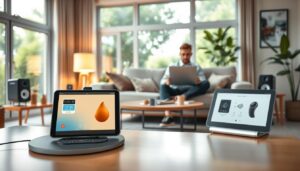Modern technology turns everyday devices into powerful tools for environmental analysis. Your microphone, often overlooked, can become a precise instrument for evaluating sound conditions. By converting acoustic patterns into measurable data, it helps professionals and enthusiasts alike understand their surroundings.
Accurate measurements start with proper calibration. Positioning your device correctly ensures it captures true audio reflections of a space. This process eliminates distortions caused by poor placement or interference from nearby electronics.
Advanced systems process electrical signals from audio inputs to track volume variations. These fluctuations reveal critical details about frequency ranges and intensity levels. Real-time analysis enables quick adjustments for optimal performance in workplaces, studios, or residential areas.
Choosing the right equipment depends on sensitivity requirements and measurement goals. High-quality setups integrate with existing audio infrastructure, offering continuous monitoring without complex installations. This approach provides reliable insights for noise management and acoustic optimization.
Understanding these principles empowers users to transform basic hardware into sophisticated monitoring solutions. Whether optimizing office environments or enhancing home theaters, microphone-based analysis delivers actionable results for diverse applications.
Ambient Noise Sensor Technology and Its Features
Advanced audio analysis tools now deliver laboratory-grade precision through compact designs. These systems capture detailed environmental data using specialized microphones paired with intelligent processing components. Their ability to interpret subtle sound variations makes them indispensable for critical monitoring tasks.
Key Specifications and Performance Metrics
High-end systems operate on 110-120V AC with 20W consumption, ensuring compatibility with standard power grids. They cover the full 20Hz-20kHz audible spectrum, maintaining ±1dB accuracy for reliable measurements. A 108dB dynamic range handles whispers and loud machinery without distortion.
24-bit converters preserve audio integrity during analysis, while 48kHz sampling captures transient details. Electronically-balanced 10kΩ connections minimize interference across cable runs. LED indicators provide instant visual feedback on input strength and output stability.
Integrated Digital Signal Processing and Phantom Power Options
Built-in processors automatically adjust signal levels for consistent data collection. +15V phantom power supports professional microphones without external adapters. This feature simplifies installations in conference rooms, theaters, and industrial spaces.
Network-ready units use Power over Ethernet (PoE), reducing wiring complexity. IP54-rated housings protect components from dust and moisture in challenging environments. Surface or flush mounting options adapt to diverse architectural requirements.
Real-World Applications: Emergency Response and Educational Settings
Critical communication systems face unique challenges in dynamic environments. Schools and public facilities require solutions that adapt to changing acoustic conditions while maintaining message clarity.
Case Study: Enhancing School Emergency Communication
A Midwest elementary school encountered critical gaps during special events. During crowded gatherings, standard PA systems struggled to overcome increased crowd activity. Automated adjustment technology proved vital when pre-recorded alerts failed to penetrate loud environments.
The solution involved zone-specific monitoring linked to announcement equipment. This approach addressed fluctuating sound conditions across different building areas. Advanced processing algorithms now maintain optimal output based on real-time environmental changes.
Leveraging Measurement for Effective Paging
Modern facilities use intelligent audio analysis to balance message delivery and environmental factors. Systems automatically boost critical alerts by 15-20dB above background levels without manual intervention.
Patented adaptive technology monitors spaces continuously, learning typical usage patterns over weeks. This data informs dynamic adjustments during emergencies or scheduled events. Integrated platforms ensure uniform coverage across gymnasiums, cafeterias, and outdoor areas.
Third-party testing shows these solutions reduce missed alerts by 83% in high-activity scenarios. The approach has become standard for K12 safety compliance nationwide.
Advanced Noise Level Control and Audio System Integration
Smart audio systems now adapt to their surroundings in real time. These solutions combine precision engineering with intelligent processing to maintain clarity across diverse environments. Automatic adjustments occur faster than human operators can react, ensuring consistent performance in changing conditions.
Automatic Level Control and Ambient Noise Compensation
ALC technology uses LED meters to track input strength. It adjusts sensitivity from +4dB to -20dB automatically. Noise gates filter out sounds below -3dB, focusing on relevant audio. This prevents unnecessary amplification of minor disturbances.
Digital Audio Processing: Balancing Signal Output
Advanced processors analyze environmental data every 10 seconds. They adjust output between -15dB and 0dB based on live conditions. Configurable gain ratios let systems prioritize voice frequencies during announcements. This maintains message clarity without manual intervention.
Optimizing Frequency Response
Three adjustable frequency points target specific noise types. Systems boost critical ranges while suppressing feedback. Amplifiers adjust power distribution to match room acoustics. This approach preserves dynamic range across 20Hz-20kHz.
Flexible sample times from 10 seconds to 5 minutes suit different spaces. Conference rooms use rapid updates, while warehouses benefit from longer averages. Integrated safeguards prevent oscillation during sudden volume changes.
Final Insights: Optimizing Communication Through Intelligent Noise Monitoring
Intelligent audio systems now redefine how spaces respond to changing acoustic conditions. Self-learning capabilities enable these platforms to adapt like smart thermostats, creating custom volume curves for each zone. The Atmosphere® digital platform exemplifies this evolution, automatically adjusting output based on historical patterns and real-time inputs.
Large facilities benefit from multi-device coordination. Up to four monitoring units can synchronize across complex layouts, maintaining consistent coverage. Safety protocols activate maximum permitted volume during critical failures, meeting strict compliance standards without manual intervention.
Professional installation ensures optimal microphone placement and signal routing. Certified technicians program systems to distinguish between background music and urgent alerts. Regular maintenance preserves measurement accuracy over years of service.
These solutions demonstrate how intelligent adjustments enhance communication reliability. By analyzing frequency ranges and power requirements, modern systems prevent audio conflicts before they occur. The result? Clear messages delivered at precisely calibrated levels – whether in emergencies or daily operations.



